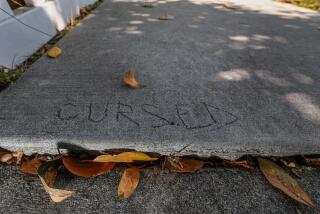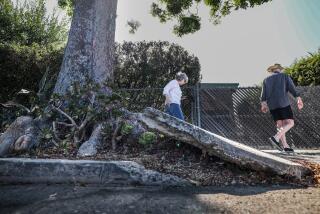Dear Street Smart: Why does it take...
Dear Street Smart: Why does it take so long to repaint the street lines after repaving? Several years ago, Sherman Way in North Hollywood was repaved and it took about six months to paint lines.
Larry Korman, Van Nuys
Dear Reader: Believe it or not, there is much, much more to striping a road in Los Angeles than just slapping down some yellow lines in the middle of the pavement. Transportation engineer Zaki Mustafa described the process:
Every time a street is repaved, the city studies how best to stripe it. That way, the lines can be redrawn in such a way as to accommodate changing traffic patterns. For instance, engineers might decide to make a left-turn lane longer or wider or eliminate it altogether, depending on traffic.
“It’s like a science,” Mustafa said.
And it takes time. First, engineers must survey the streets. Then they design new lane lines and other markings. Then the plans are reviewed.
Next, guide marks are placed in the street so engineers can drive the street to make sure what looks good on paper actually works and is comfortable for the average motorist. Finally, the permanent stripes are put in place. The process can take months.
Mustafa admits that it would make sense to time all this designing and testing so that it is completed about the time the repaving is. But it does not always work that way. Hence, delays.
Each year, the city’s traffic engineering department--which designs the striping--receives a list of repaving projects to be undertaken by the Bureau of Street Maintenance. Mustafa points out, however, “that the list does not actually mean that is what they are working on.”
Projects often are added to or dropped from the list as road conditions dictate.
Sometimes, traffic engineers--who are in the Department of Transportation--are not told by the street maintenance staffers--who are in the Department of Public Works--that a project will begin until the day before repaving actually starts. That puts the engineers behind the work curve, Mustafa said. In addition, the department is short several engineers so fewer people are handling the same amount of work.
Mustafa said his department hopes to hire new engineers soon.
As regular readers know, we devote space from time to time to discussions of interest. A question last week asking how “The Grapevine” stretch of Interstate 5 got its name prompted a few letters with new perspectives. Here are a couple.
*
Dear Street Smart:
This is in reference to the question of what is “The Grapevine.” I know that you did not solicit any comments on the subject, but I thought that I might as well add my 46 cents (plus postage).
I guess it all depends where you lived when you first heard the nickname. I would like to vote for the “old wives tale” version--the one that believes the name was given due to the very long and very twisted way that it went down the hill into Castaic.
Anyone who has had the opportunity to drive that road before Interstate 5 was constructed knows that the stretch of road between Gorman and the community of Grapevine was nothing compared to the stretch of road between Gorman and Castaic.
I can believe the tale that Grapevine Canyon was named for the abundance of grapevines in the area, but the old road was nicknamed The Grapevine because of the way it twisted down the hill on the south end of the Tejon Pass.
David Sumner, Reseda
On the same subject, a pair of longtime drivers of the route add their view and a bit of history.
*
Dear Street Smart: We are 71 years old and have traveled between here and Bakersfield most of our lives. We always called everything (along Interstate 5) but the Grapevine section the Ridge Route and wonder when that changed. It’s still the ridge to us.
In the Grapevine section of the route, there were actual grapevines growing along the hillside where people stopped at the watering hole for their boiling engines.
Joe and Juanita Lane, Burbank
More to Read
Sign up for Essential California
The most important California stories and recommendations in your inbox every morning.
You may occasionally receive promotional content from the Los Angeles Times.










